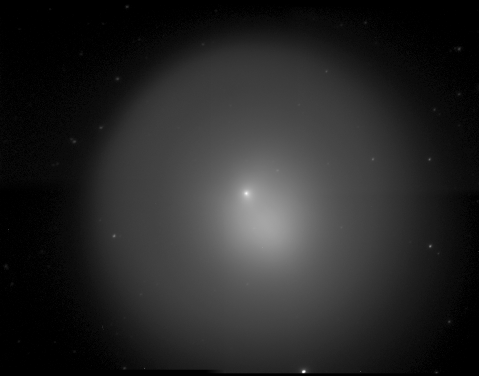
| Description: This mosaiced image spans roughly 11' x 8.5'. The bright expanding shell of material blown off the comet is around 9' to 10' (52 Earth diameters) wide here, with the brighter inner region roughly 3.5' (38 Earth diameters, or roughly the distance to the Moon) across. The nucleus is displaced by about 40" (7 Earth diameters) from the centre of the cloud. The outburst was reported on the 25th, meaning the cloud is expanding at over a kilometre a second!
Image information: Mosaiced combination of 4 x 10s white-light images. Image taken
31/10/2007 19:20-19:25 UT.
Physical information: Magnitude: roughly 3, dist. from Earth: 1.62AU, dist. from Sun: 2.47AU.
|
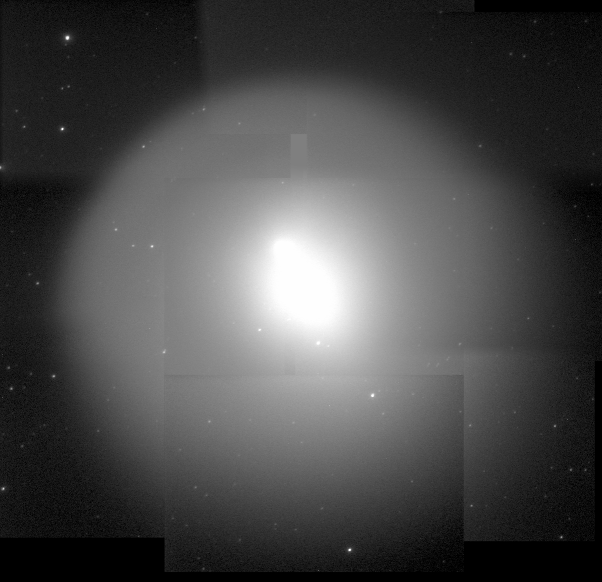
| Description: Another mosaiced image in slightly poorer
conditions, on the same scale. The contrast on the image has been
increased slightly from the previous observation to bring out the cloud
better. The expansion of the cloud can be clearly seen, though there is no
evidence here of a tail, as imaged by some astronomers at this time.
Image information: Mosaiced combination of 10 x 10s white-light
images. Image taken 03/11/2007 20:00 UT.
Physical information: Magnitude: roughly 3, dist. from Earth:
1.62AU, dist. from Sun: 2.48AU.
|

| Description: Another mosaiced image in better conditions
conditions, on the same scale. The expansion in the eight days between images is quite apparent here, and the non-circular nature of the comet's coma is clearer on this image. The nucleus is now at a considerable distance from the centre of the expanding cloud, though is still 'surfing' the edge of the inner shell. Note also that the nucleus is now much fainter.
Image information: Mosaiced combination of 10 x 10s white-light
images. Image taken 11/11/2007 18:35 UT.
Physical information: Magnitude: roughly 4, dist. from Earth:
1.62AU, dist. from Sun: 2.51AU.
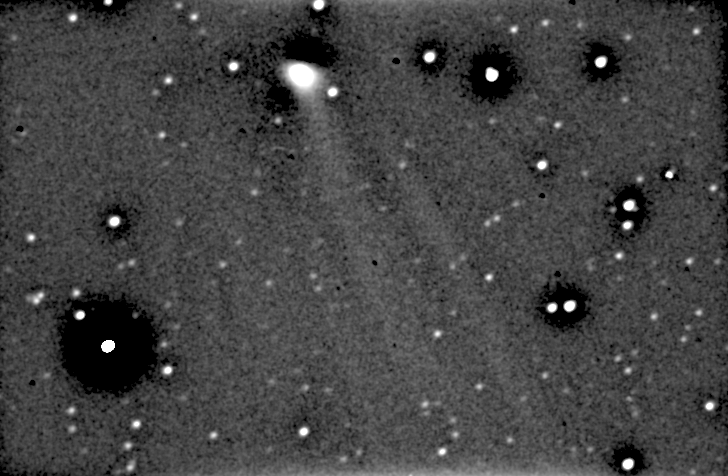
| Description: By taking a Fast Fourier Transform of the gas cloud, we can detect faint structure in the cloud, though to be jets eminating from the nucleus. See here for a better image!
Image information: Stacked combination of 16 x 10s white-light
images, FFT high-pass r=16, Gaussian blur r=1. Image taken 11/11/2007 18:50 UT.
Physical information: Magnitude: roughly 4, dist. from Earth:
1.62AU, dist. from Sun: 2.51AU.
|
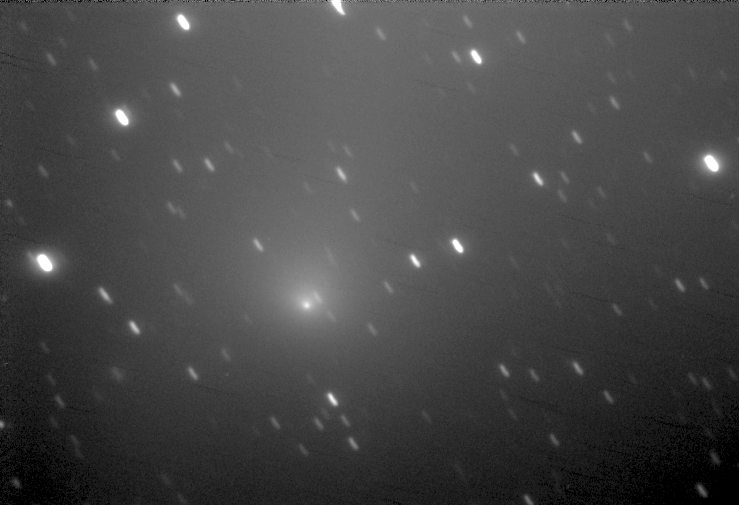
| Description: In this image, a month later, the comet's coma has expanded over several times the field of view to about the same angular size as the full Moon. The comet's coma can clearly be seen around the nucleus. The horizontal dark streaks are image processing artifacts due to the faintness of the coma, but the gradient in the background is real.
Image information: 81 x 10 second exposures, calibrated and stacked. Image taken: 10 December 2007, 22:00 UT.
Physical information: Integrated magnitude (including coma) about 4,
dist. from Earth: 1.76AU, dist. from Sun: 2.63AU.
|
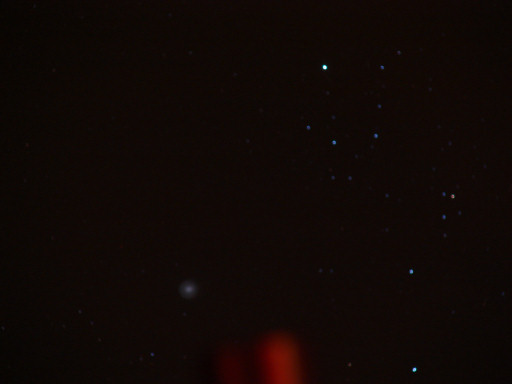
| Description: By this point in time, comet Holmes was easily
visiblie with the naked eye as a fuzzy blob. Even the smallest instrument
is capable of resolving its structure, as seen from this digital camera
image from my digital camera, piggy-backed on the end of Keele's 17"
telescope.
Despite being slightly out of focus, the comet's structure is clear.
The bright star in the upper-right corner is alpha Perseii, which has its
associated group of (blue) stars. The stars in the bottom-right are theta
and delta Perseii. The unusual red blob is actually the end of the 17"
telescope! The whole field spans approximately 6 x 4.5 degrees.
Image information: 30 second exposure, piggy-backed onto the 17"
telescope for tracking, using a Sony DSC-H1 digital camera. Image taken:
03/11/2007 22:00 UT.
Physical information: Magnitude: 3.7 (as estimated from image),
dist. from Earth: 1.62AU, dist. from Sun: 2.48AU.
|
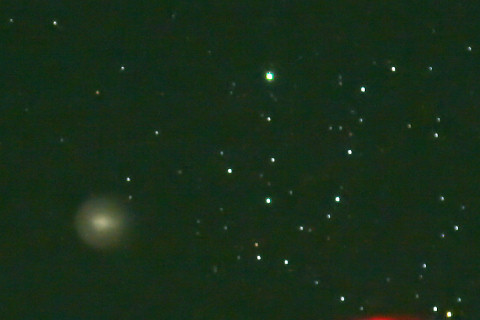
| Description: A closer image of the comet, taken eight days later. Comparing the two images, the comet can be seen to have moved much closer to the alpha Persii moving group. The image has been contrast-enhanced more to bring out fainter detail and is zoomed in a little more. The field is approximately 4 x 3 degrees.
Image information: 30 second exposure, piggy-backed onto the 17"
telescope for tracking, using a Sony DSC-H1 digital camera. Image taken:
11/11/2007 19:28 UT.
Physical information: Magnitude: approx. 4,
dist. from Earth: 1.62AU, dist. from Sun: 2.51AU.
|
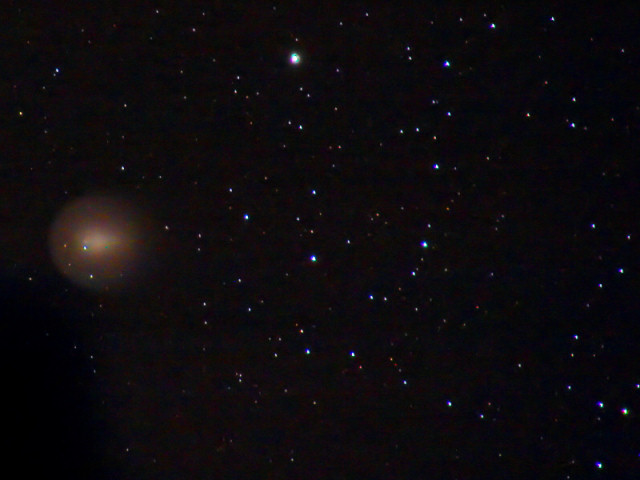
| Description: Closer still, two days after the previous image. The comet has once again moved and grown, and the asymmetry is developing further. The field covers just under 3 x 2.5 degrees.
Image information: 30 second exposure, piggy-backed onto the 17"
telescope for tracking, using a Sony DSC-H1 digital camera. Image taken:
13/11/2007 20:31 UT.
Physical information: Magnitude: approx. 4,
dist. from Earth: 1.63AU, dist. from Sun: 2.52AU.
|
Back to: Gallery, Home
|







